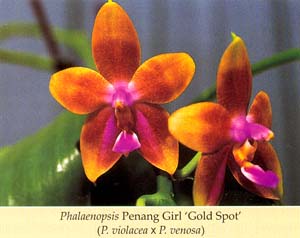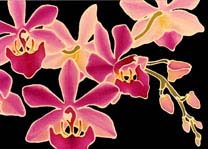Hybridizing with Phalaenopsis Species
by Bill Livingston
Phalaenopsis venosa
|

A well-grown plant can have six to seven inflorescences at a time, with two to seven flowers per branch. The waxy and fragrant flowers can be 1.5 to 2 inches in diameter and round in form, but their aroma is not as nice as some other species. There are two color forms, mahogany and mustard green. The base color of all segments is white with an overlay of the two color forms showing; sometimes barring appears when the colors are lighter. These colors cover about 90% of the flower area, leaving clear white around the flower's column, with the anther cap showing a light lettuce green color. All of its hybrids show this white to light color, which immediately indicates it is a P. venosa cross. The lip is just about all white except on each side of the midlobe which shows a small line of maroon veins. The leaves are elongated and have a pippin apple green color. In my estimation, the clone of P. venosa 'Red Mahogany' AM/AOS awarded in 1983 is one of the two best clones I have seen. The other clone, 'Del Rosa', was owned by Bob Gordon. I am sure there are a few clones I have missed seeing, but I would have been pleased to have the above two on my stud bench for hybridizing because of their outstanding shape and dark mahogany color. Some hybridizers have claimed P. venosa has a problem with fertility. They can make a cross, but cannot continue hybridizing through to the next generation. However, from the looks of some of the progeny many of the hybridizers were making triploid crosses, and quite often were up against a brick wall. Study the crosses which are made in second and third generations, and see which clones were used. There were some chance tetraploids appearing from some crosses, and a number of crosses made with diploids.

I feel H. P. Norton is either a wise or extremely lucky hybridizer, as I will explain. He hybridized P. Golden Belle (P. Golden Sands x P. venosa). Phalaenopsis Golden Sands is a known triploid, and when Norton crossed it with P. venosa, a diploid, the cross produced some tetraploids and aneuploids. When P. Ambonosa (P. venosa x P. amboinensis) was made, the hybridizer was guaranteed breedable plants, because both clones were diploids, easily producing lots of seed, but with small flowers. What Norton did was then to produce hybrids which would enlarge the flower size.
I would recommend P. venosa as a stud plant, as well as P. Golden Belle which has not yet shown all of its colors and capabilities. You will have a strong yellow to breed on yellows, and crossing with pinks and reds will give you an array of outstanding colors as well as large flowers, On reflection, small brightly colored flowers are nice too, but it is up to you to create what you have envisioned in your mind's eye. I have really raved on about this species, but I think one can produce some nice flowers providing one follows the genetics as outlined above.
|
|



This article which has been reprinted here with permission, originally appeared in the Volume 66, Number 4 edition of Orchid Digest, (Oct-Dec 2002), which is a Special Edition that highlights Phalaenopsis, and also features an excellent article on Phal culture by the Tuskes. The Phalaenopsis Special Edition of Orchid Digest can be ordered from Orchid Digest for $22. Highly recommended.
This article, all of its sections and accompanying photographs
are copyright 2002 by Orchid Digest Corporation.
Note: This site uses Javascript Navigation Controls;
if you have Javascript disabled on your Browser,
you will need to use the Site Map to navigate this site.
|



